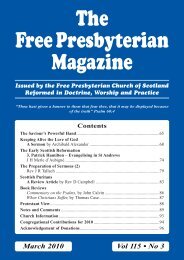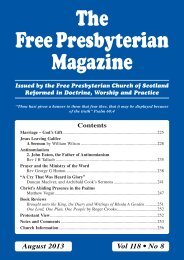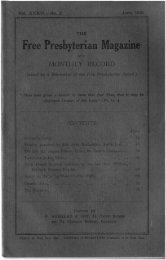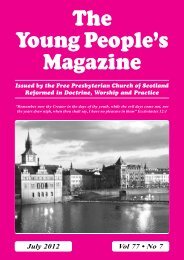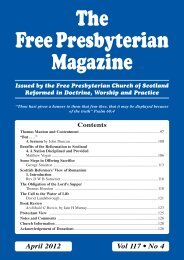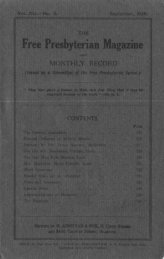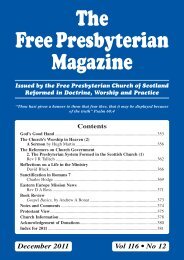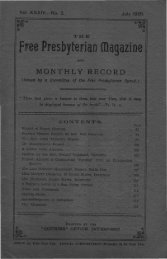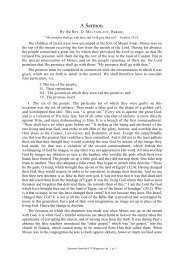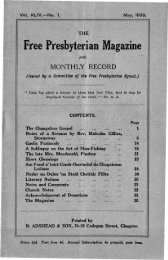May - the Free Presbyterian church of Scotland
May - the Free Presbyterian church of Scotland
May - the Free Presbyterian church of Scotland
Create successful ePaper yourself
Turn your PDF publications into a flip-book with our unique Google optimized e-Paper software.
Scottish Reformers’ View <strong>of</strong> Romanism 141<br />
Scottish Reformers’ View <strong>of</strong> Romanism 1<br />
2. Historical Survey <strong>of</strong> <strong>the</strong> Pre-Reformation Period<br />
Rev D W B Somerset<br />
The Lollards <strong>of</strong> Kyle. Kyle is a district <strong>of</strong> Ayrshire, and <strong>the</strong> Lollards<br />
(1.) <strong>of</strong> Kyle were flourishing in 1494, 30 years before Patrick Hamilton.<br />
The name Lollard shows that <strong>the</strong>y derived, ultimately, from John Wycliffe,<br />
who had died in 1384. Thirty <strong>of</strong> <strong>the</strong>m, including Adam Reid <strong>of</strong> Barskimming,<br />
were summoned before James IV at <strong>the</strong> instigation <strong>of</strong> Robert Blackadar, Archbishop<br />
<strong>of</strong> Glasgow; and 34 articles <strong>of</strong> accusation were brought against <strong>the</strong>m.<br />
These articles are listed in John Knox’s History (Archbishop Spottiswoode’s<br />
History gives a shorter list). Being articles <strong>of</strong> accusation, <strong>the</strong>y must be treated<br />
with caution because <strong>the</strong>re is always a likelihood <strong>of</strong> misrepresentation and<br />
exaggeration. Assuming, however, that <strong>the</strong> articles reasonably reflect <strong>the</strong>ir<br />
views, <strong>the</strong>y were very much followers <strong>of</strong> Wycliffe’s doctrine.<br />
The articles make interesting reading: “(1) They said that it was wrong to<br />
have or to worship images. (2) It was wrong to worship relics <strong>of</strong> saints. (7)<br />
That after <strong>the</strong> consecration in <strong>the</strong> mass <strong>the</strong>re remains bread, and <strong>the</strong>re is not<br />
<strong>the</strong> natural body <strong>of</strong> Christ. (12) That <strong>the</strong> Pope is not <strong>the</strong> successor <strong>of</strong> Peter<br />
except where Christ said, ‘Go behind Me, Satan’. (13) The Pope deceives<br />
people by his bulls and indulgences. (14) That <strong>the</strong> mass pr<strong>of</strong>iteth not <strong>the</strong><br />
souls that are in purgatory. (17) That <strong>the</strong> Pope exalts himself against God<br />
and above God. (19) That <strong>the</strong> blessings <strong>of</strong> bishops [<strong>of</strong> dumb dogs, <strong>the</strong>y should<br />
have been styled, says Knox] are <strong>of</strong> no value. (22) That priests might have<br />
wives, according to <strong>the</strong> constitution <strong>of</strong> <strong>the</strong> law. (32) That <strong>the</strong> Pope is <strong>the</strong><br />
head <strong>of</strong> <strong>the</strong> kirk <strong>of</strong> Antichrist. (28) That we should not pray to <strong>the</strong> glorious<br />
Virgin Mary but to God only. (31) That such as worships <strong>the</strong> sacrament <strong>of</strong><br />
<strong>the</strong> kirk [that is, <strong>the</strong> bread and wine] commits idolatry. (33) That <strong>the</strong> Pope<br />
and his ministers are murderers.”<br />
The articles are against images, <strong>the</strong> mass, <strong>the</strong> worship <strong>of</strong> <strong>the</strong> Virgin Mary,<br />
and especially <strong>the</strong> Pope. They rejected images, presumably because <strong>of</strong> <strong>the</strong><br />
Ten Commandments. They almost certainly did not have <strong>the</strong> Old Testament<br />
in English – though <strong>the</strong>y probably had it in Latin – but <strong>the</strong>y might well have<br />
had <strong>the</strong> Ten Commandments in English. They rejected prayer to <strong>the</strong> Virgin<br />
Mary because <strong>the</strong>y found in <strong>the</strong> New Testament that God is <strong>the</strong> only object<br />
<strong>of</strong> worship and that Christ is <strong>the</strong> only Mediator. Their rejection <strong>of</strong> <strong>the</strong> mass<br />
was fairly comprehensive: <strong>the</strong>y rejected transubstantiation, <strong>the</strong> sacrifice for<br />
<strong>the</strong> dead in purgatory (though <strong>the</strong>y seem to have accepted purgatory itself),<br />
and <strong>the</strong> worship <strong>of</strong> <strong>the</strong> elements, but <strong>the</strong>y did not see <strong>the</strong> mass as essentially<br />
1 The previous article provided an introduction to <strong>the</strong> subject.



